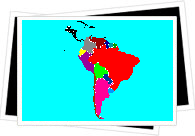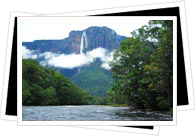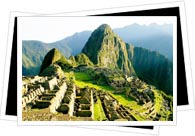
South America is the southern of the two American peninsulas. It comprises Argentina, Bolivia, Brazil, Chile, Columbia, Ecuador, the Falkland Islands, French Guiana, Guyana, Paraguay, Peru, South Georgia and South Sandwich Islands, Suriname, Uruguay and Venezuela.
South America encompasses 3.5% of the Earth's surface, an area of 17,840,000 square kilometres (6,890,000 square miles).
The main language spoken is Spanish, followed by Portuguese, although it is estimated that some 1000 different languages are spoken in South America, including tribal languages. The peninsula is separated into 4 different time zones GMT-3, GMT-4 (Atlantic Standard Time), GMT-5 (USA Eastern Standard Time) and GMT-6. South America is located within Latin America which also incorporates the Caribbean and Central America. Latin America is the general term for the countries whose roots are from Latin Europe.

Probably most famous for the architecture ruins which now remain from the native Amerindian people of times past, superstars such as Shakira and world class footballers such as Diego Maradona, South America can also boast the biggest waterfall in the world - Angel Falls in Venezuela, the breathtaking Andes mountains, the dramatic Amazon rainforest and some of the largest and most spectacular fiestas in the world - the flamboyant yearly carnivals in Brazil.
It is generally thought that the inhabitants of South America came from Siberia, reaching the peninsula some 12,000 to 14,000 years ago. From then until modern times, agriculture has been the main occupation of the people. Potatoes, chillies and beans have been cultivated there for the past 8500 years. Corn, yucca, coffee, beef, cotton, sugar cane, cacao, bananas, citrus fruits, tuna fish and anchovies are all now cultivated too, much of which is exported around the world.

The largest Amerindian group in South America was the Inca. They were based in what is now Peru and from the year 1200AD started to increase their empire. Originally they were farmers, but within a century had become accomplished builders and stonemasons. In 1438 their expansion literally exploded as they conquered a neighbouring state and then worked their way expanding throughout the Andes. In just over fifty years, the Inca empire had extended from Quito in modern day Ecuador, south to Chile's Maule River, a distance of about 4000km (2500 miles).
1532 is the year when the Inca fell from power. The Inca people were divided about which son should be ruling the empire, following the death of their leader a few years previous. When the Spanish arrived, led by Francisco Pizarro, the invaders were able to overcome the 40,000 strong Inca army with their guns and diseases to which the Inca had no natural resistance. Three years later the Inca empire had been overthrown. The incredible architecture of the Inca, however, can still be seen today.
Peru in particular has many Incan sites which can be viewed and explored. The urban citadel of Machu Picchu situated high in the mountains is probably the most famous Inca site and was added to UNESCO world heritage site list in 1983. Following an earthquake in 1950 which destroyed much of the city of Cusco, the Temple of the Sun was exposed, with the church having been built above it, in addition to other original Incan walls of the city. Cusco is also on the UNESCO heritage list, totalling 80 locations in South America listed as protected sites.